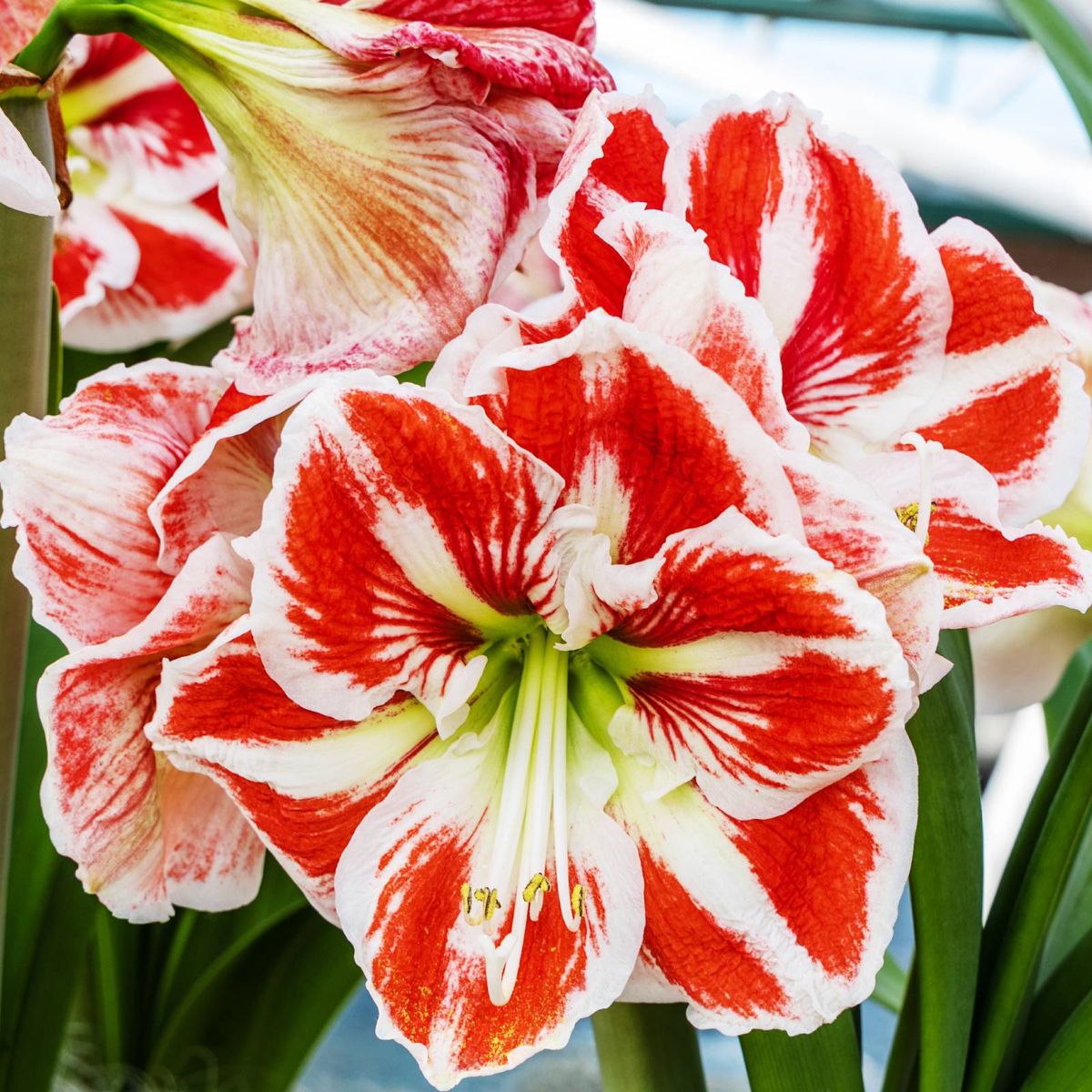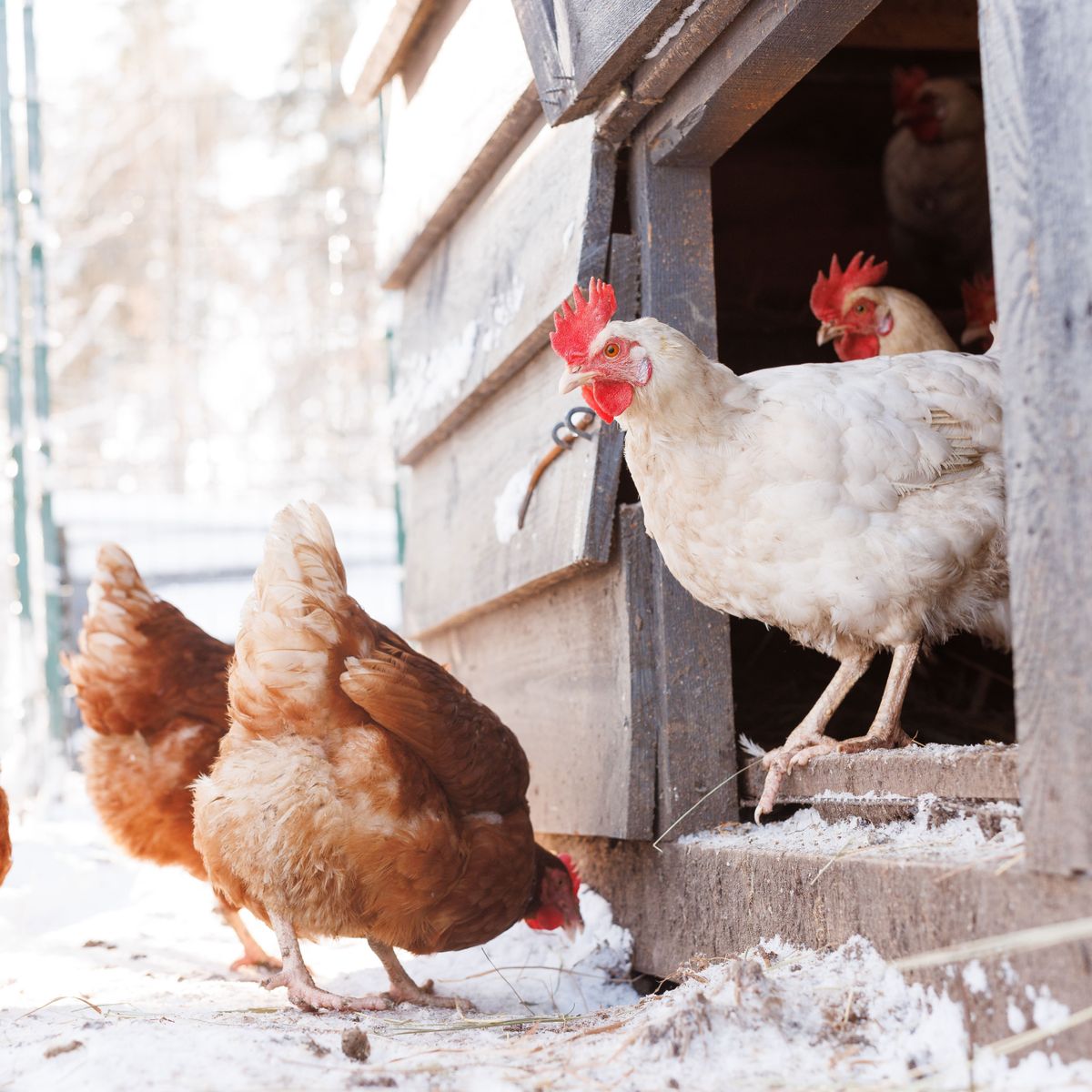We link to vendors to help you find relevant products. If you buy from one of our links, we may earn a commission.
Limited space can put a serious damper on indoor gardening, but hydroponics – or growing food and other plants using water in place of soil – can be an excellent alternative.
And “Home Hydroponics: Small-Space DIY Growing Systems” by Tyler Baras, available via Amazon, is a fantastic resource to get you started.
Most people don’t have space inside their homes for an ugly, sprawling configuration of pipes, basins, and light bulbs like what is typically designed for installation inside laboratories, garages, and greenhouses.
Modern-day commercially available units have changed the game of indoor hydroponics, with many shrunk-down options that are quieter and less demanding to maintain.
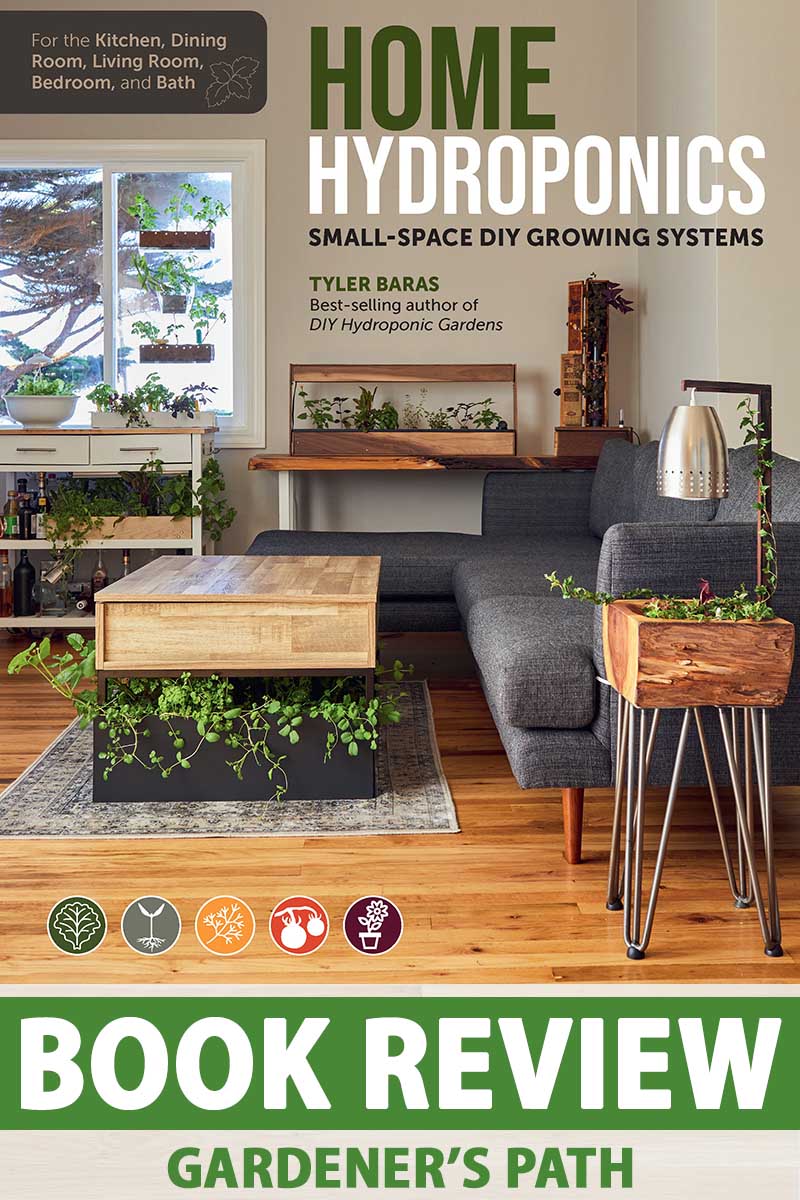
Countertop units like the AeroGarden typically have a very sleek, contemporary appearance and are relatively easy to maintain – but not everyone appreciates that specific style.
If you’d prefer a more rustic or aesthetically pleasing look to blend with your interior decor, you should consider building your own model.
You’ll need to plan the design with many factors in mind, including crop yield, placement inside the home, and what type of plants are suitable for growing in the unit.
It might seem a little overwhelming to figure all of that out, but that’s where “Home Hydroponics” comes into play.
You’ll learn everything you need to know about planning and constructing a beautiful, functional, indoor hydroponic garden that fits seamlessly into the space you’ve got!
Here’s everything we’ll cover in our review:
Home Hydroponics: Small Space DIY Growing Systems
Who Is Tyler Baras?
“Home Hydroponics” is Baras’ third release. His first two books, “DIY Hydroponic Gardens,” and “Roadmap to Growing Leafy Greens and Herbs,” were published in 2018.
Obviously, after penning three books about growing plants in soilless systems, it’s apparent that hydroponics is a passion of his, and it shows in his detailed writing.

Baras, also known as “Farmer Tyler,” has a strong academic background as well as practical experience in topics ranging from homesteading to commercial and urban farming, so he genuinely knows his stuff.
Holding a bachelor’s degree in horticultural sciences from the University of Florida, with additional studies in organic agriculture and greenhouse production in Spain and China under his belt, he put his education into practice working as a grower at 3 Boys Farm, a USDA-certified organic recirculating hydroponic farm in Florida.
In the years since, he has held various other positions including farm manager, senior grower, and educator.
Repeat appearances on P. Allen Smith’s national public television series “Garden Home” put him on the map in 2015 as an up-and-coming expert.
Baras continues to spread the word about a range of farming and food production techniques with a special focus in hydroponics while remaining busy as a frequent video contributor to Urban Ag News, and as a consultant with his own company, Farmer Tyler, LLC.
About the Book
The front cover is very eye-catching, featuring a large, glossy photo of a living room that has been fashioned into a utopia of hand-built indoor hydroponic gardens.

Home Hydroponics: Small-Space DIY Growing Systems
It appeals to me because it looks like it could easily be a room in my own home, and perhaps you’ll feel the same way. Several of the units shown are cross-functioning as furniture, rather than being individual, singular-purpose pieces that may create clutter.
Released by Cool Springs Press on September 24, 2021, the cover includes a note that the gardens featured inside are suitable for a range of rooms and small spaces including the kitchen, dining room, living room, bedroom, and bathroom.
Since many hydroponic gardens are designed to sit on the kitchen counter, this is a boon to those with limited counter space.
With a slim three-quarter-inch profile, this book is eight and a half inches wide by 11 inches high. Inside, you’ll find 192 pages packed with information, full-color glossy pictures, and easy to read charts.
The introduction and contents were written by the author, while the cover photo and interior images were provided by Colleen Eversman of 2nd Truth Photography. There are more than 250 photos inside, so if you prefer a book with a blend of copy and images rather than acres of dry text, this will be right up your alley.
Softcover and Kindle versions are available via Amazon.
The Contents
Rather than being organized into individual chapters, the book is divided into four main sections, with each one providing useful details and instructions in a brief, concise way that’s easy to understand.
The text is broken up into further subcategories that are listed in the table of contents for easy reference, with images, diagrams, and call-out boxes throughout that make this book enjoyable to read, and user-friendly.
Let’s take a look at what’s included in each of the four main categories that are covered.
Considerations for Selecting a Garden Design
In this section, Baras discusses the considerations necessary for selecting an appropriate garden design and location inside the home.
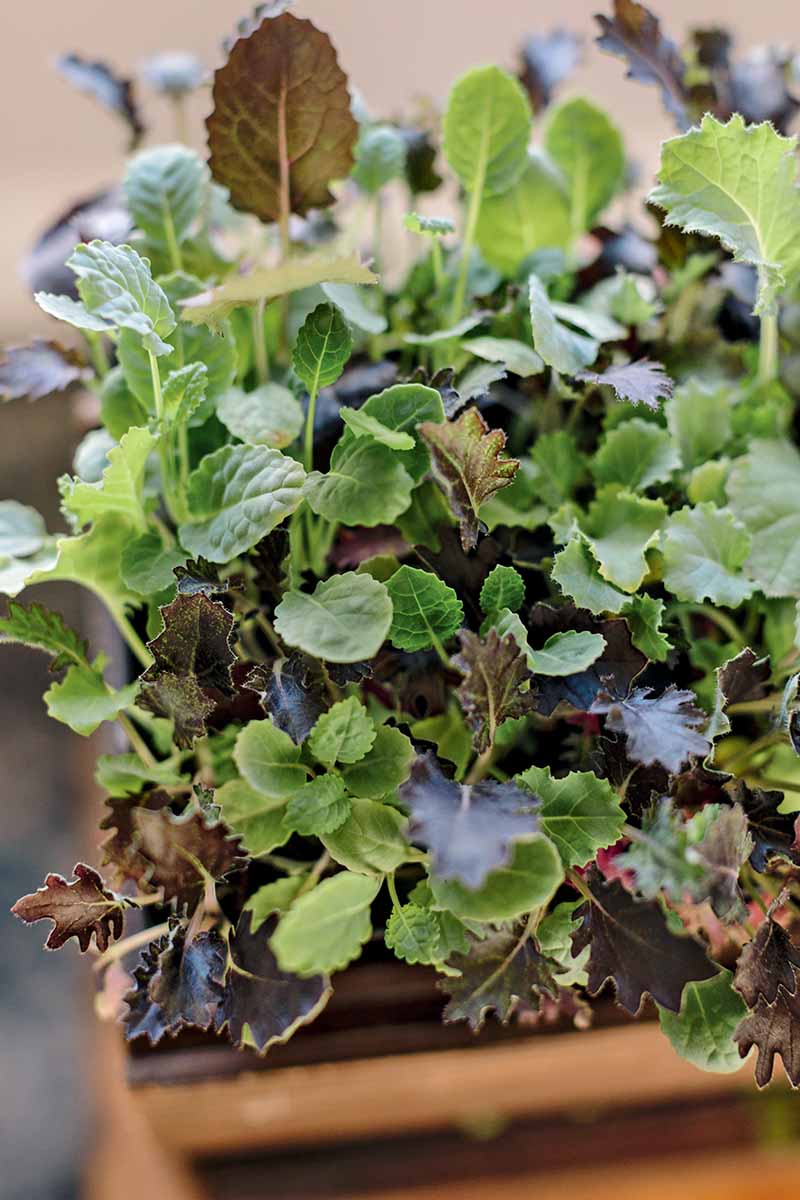
He outlines considerations such as cost, aesthetics, form, and other key elements to contemplate as you decide which garden is right for you, including a comparison between DIY and prefabricated options, which could become outdated over time as the available technology changes.
According to the author, one major factor to bear in mind as you prepare to build your own hydroponic garden is yield potential.
Variations in yield are dependent upon several factors, including necessary maintenance, which can require a significant amount of time and may impact your choice when you decide which system you want to build.
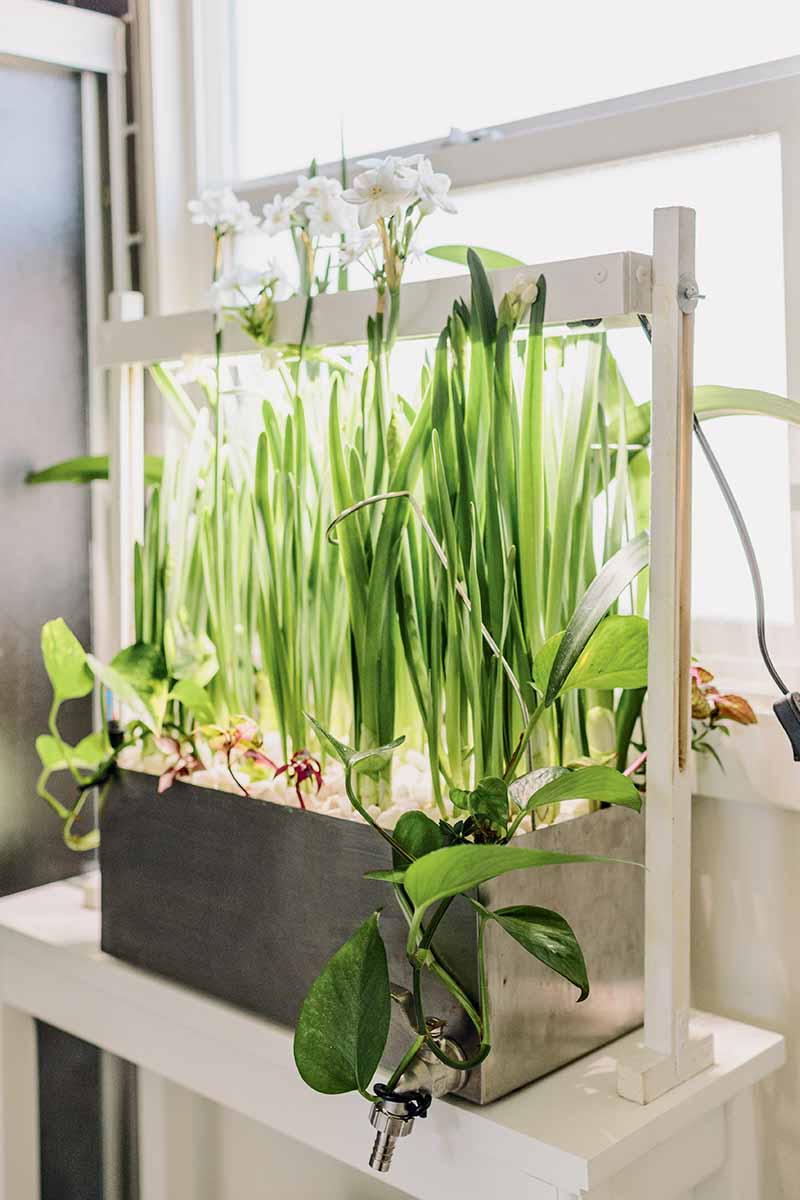
He also compares the amount of space necessary for growing salad greens as opposed to herbs to produce enough crops to fulfill your dietary needs.
This is important to understand if your goal is to significantly supplement your available produce or to grow all of your own edible crops at home, rather than devoting space to things like ornamental houseplants, for enjoyment or visual interest.
Indoor Growing Fundamentals
Plant needs such as light, climate, and nutrients are sketched out in this section.
The selection of appropriate plants is covered in detail, with a strong focus on root oxygen demand as the text explains that adequate oxygenation is imperative for healthy growing in a soilless environment.
This is the only section of the book that beginners to hydroponics, or to gardening in general, might need to devote a little extra time to as they read.
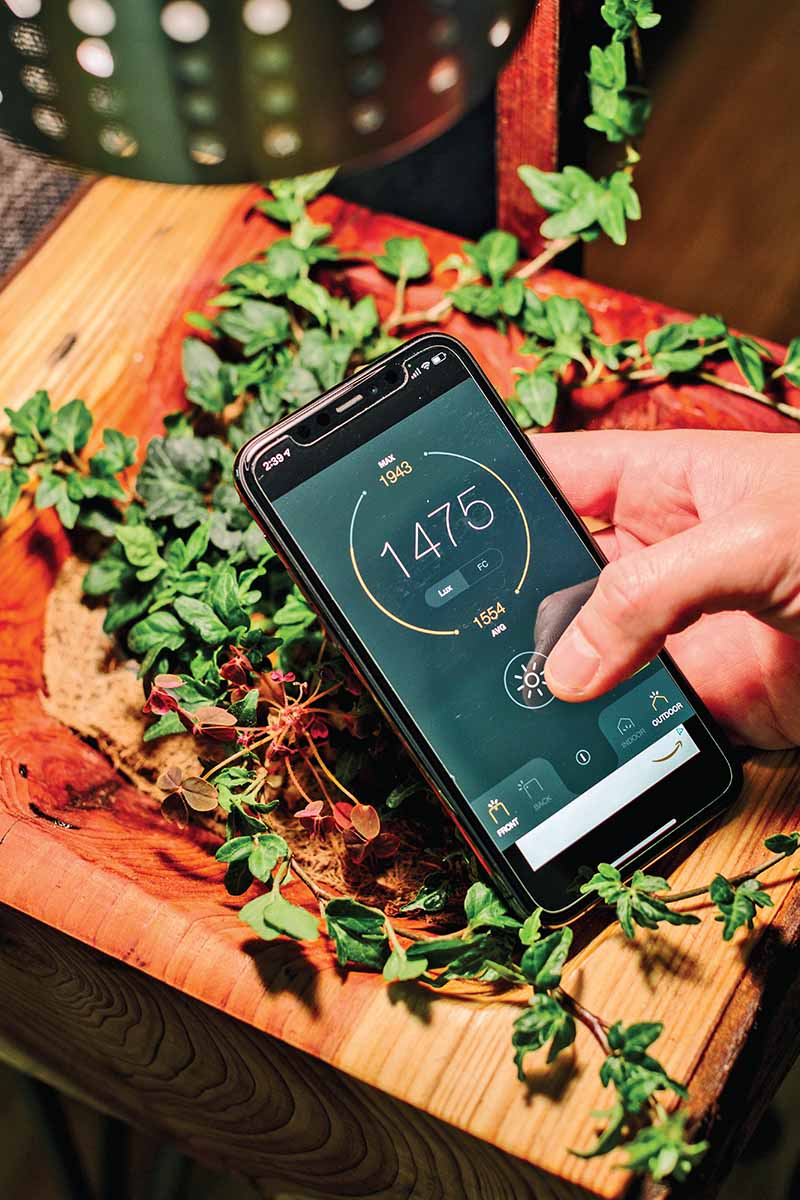
Unless you have experience with technical concepts in botany, such as measuring and converting lux, a measurement of light as the human eye perceives it, into photosynthetic photon flux density (PPFD) or the amount of light with wavelengths capable of powering photosynthesis, to get your target daily light integral (DLI) range, for example, it may seem a bit complex at first.
However, Baras is thorough in his explanations, and more information is available via his website.
He offers a video series that goes over this information in a format that might work better for visual or auditory learners as a supplement to the book.
Hydroponic Systems
Here’s where we get into the meat of the book, and it begins just 33 pages into the text, so there’s no long wait for the best part.
The chart on the first page of this section is an outstanding resource that organizes 14 projects according to building, operation, and maintenance difficulty using an easy to understand rating system.
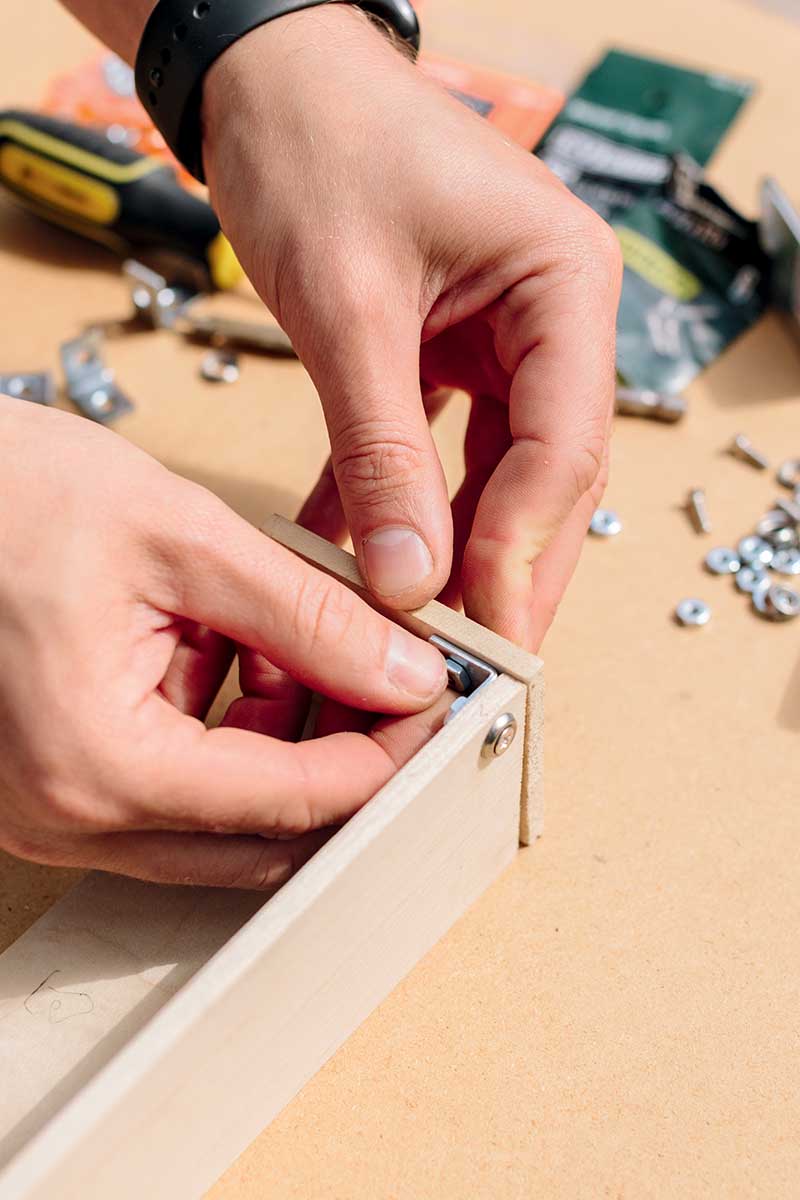
Complexity is assigned a value between one and five, with one being the least and five being the most complex.
Price and yield are included and organized using the same numeric ratings, and Baras even notes which gardens you can expect to produce sound, such as that made by a running pump or tinkling water. Some of the gardens are silent, an added bonus that many indoor gardeners will appreciate.
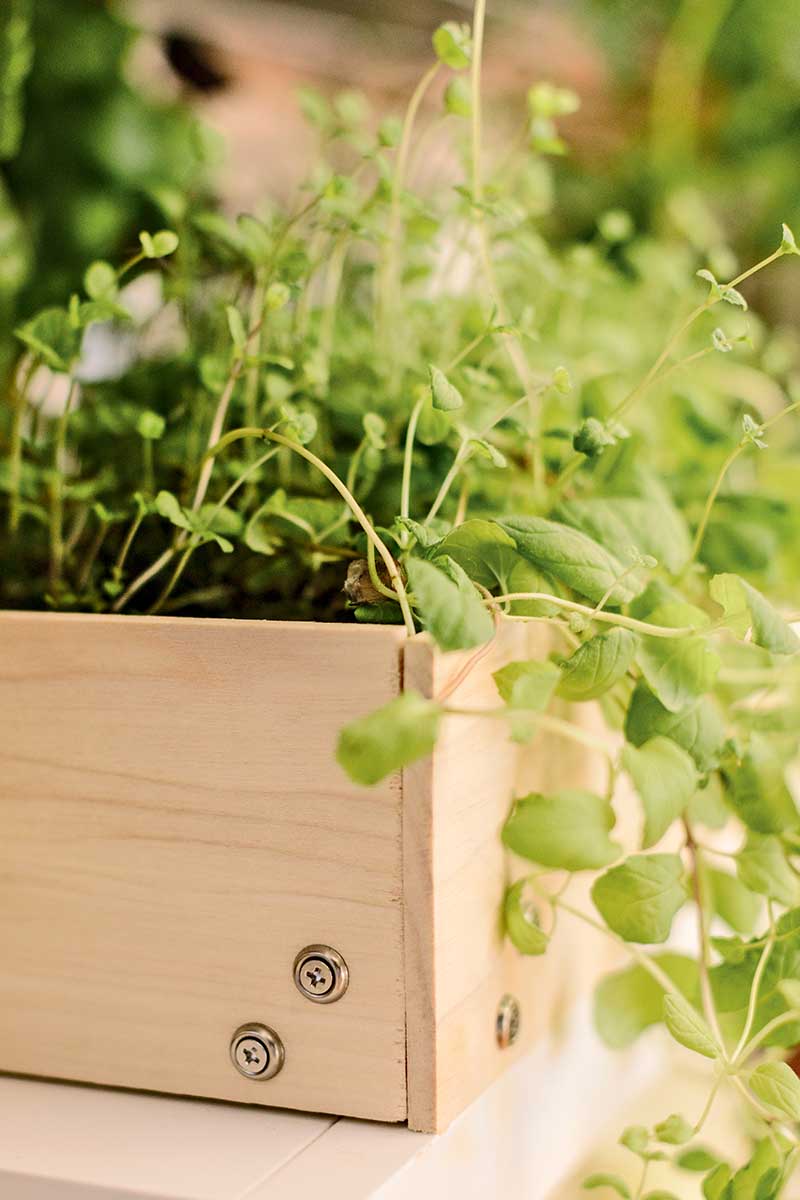
The key defines a system of symbols used to indicate suitable crop options for each unit as well, while the chart illustrates the size of a compatible hydroponic garden depending on which plants you intend to grow.
According to the key, recommended crop options include herbs, salad greens, dwarf tomatoes, short flowers, baby or microgreens, seedlings, and mushrooms, although there is mention of a Venus flytrap planted in one garden, which I’m partial to.
The building plans in this section are grouped according to the area of the home that they’d work best for: in a window, the kitchen, the bar, the dining room, the living room, and the bathroom.
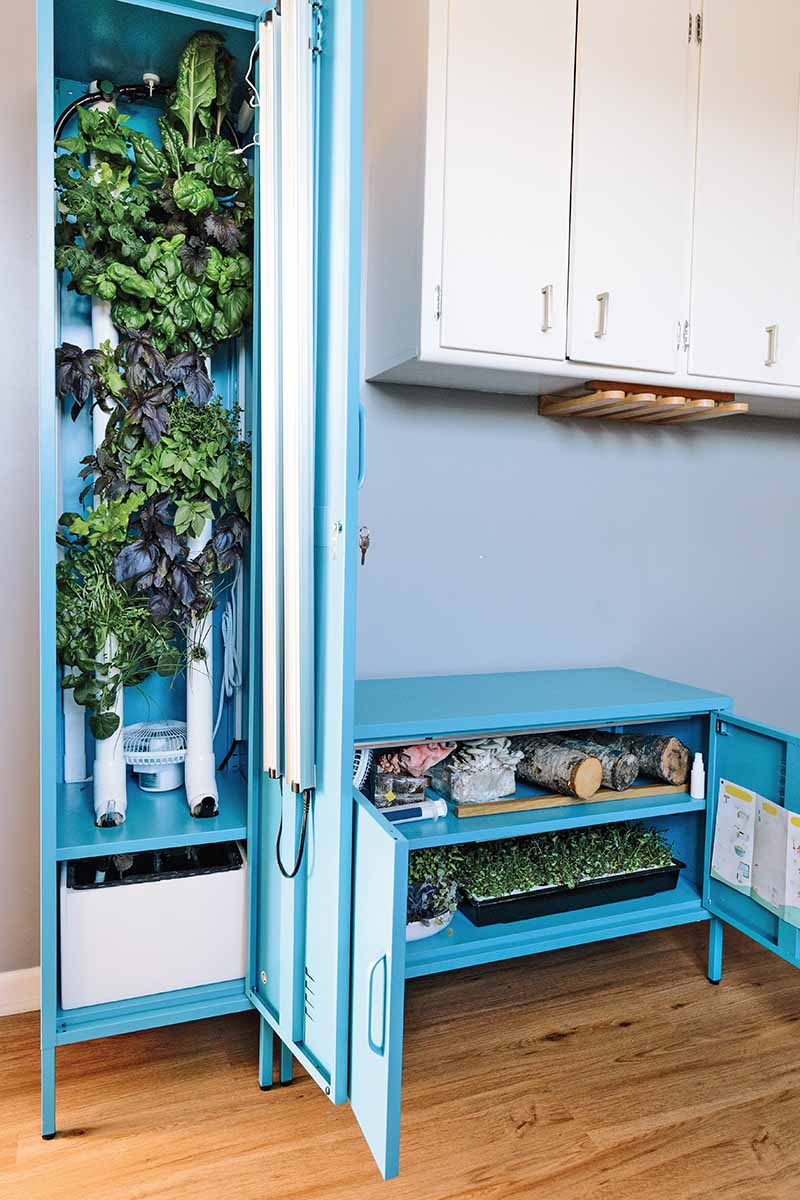
Several plans suggest using reclaimed materials, such as barnwood planks or whiskey crates, for upcycling into pieces with character that lean away from “industrial,” utilitarian appearances.
The author explains that his goal is to hide the mechanical parts to create pieces that function and produce food or other plants while adding artistic depth and warmth to the home interior.
A few of the other plans allow readers of this guide to build upon an existing cabinet or table, with detailed steps for customizing the units to make them suitable for growing.
Once the furniture items are completely assembled, most can be placed in an entryway or against a wall where they can be utilized as hydroponic systems while multitasking as functional surfaces.
The drawbacks are few for most of these projects, but a few potential downsides are mentioned for each one. This is helpful if you’re concerned about having limited time for maintenance, or inadequate light sources for growing certain crops.
System Operation
The final section delves into system operation, covering topics including starting seeds or cuttings, fertilizing, cleaning, plant health including pests and disease, and troubleshooting.
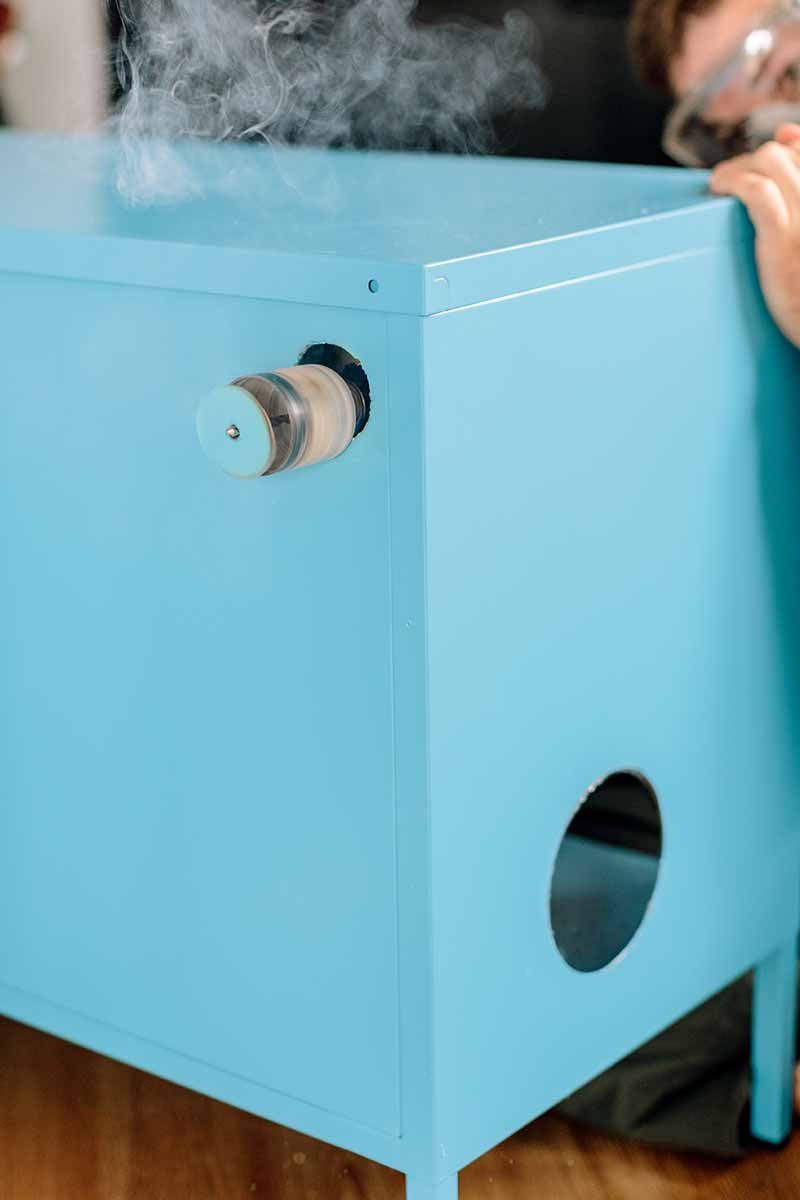
If you’re not a novice gardener, you might feel compelled to skip this section, but I wouldn’t recommend it.
Baras describes propagation specifically as it pertains to indoor hydroponic growing – and of course, this method differs from what you might be used to when gardening outdoors or growing plants in soil.
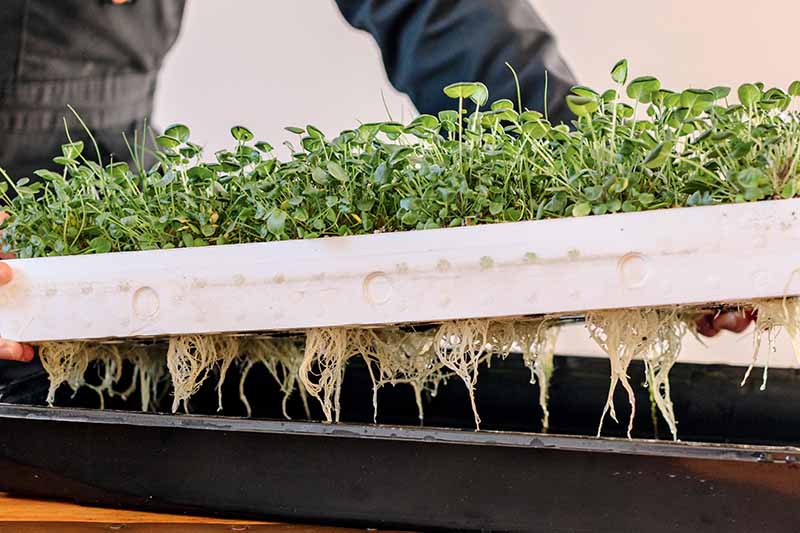
From choosing the proper materials to craft a floating deck, to explaining which systems are the most susceptible to specific types of disease, Baras covers everything in this comprehensive guidebook.
You may find some information is a review for you, but at least you won’t be blindsided by maladies that you didn’t anticipate wiping out your entire crop.

There’s also a useful appendix in the back of the book that offers conversion tables, crop selection and measurement conversion charts, and a handy index that makes it easy to quickly track down key points.
Overall Impressions
Rather than offering quips and anecdotes, Baras opts for adding little narration, choosing instead to remain on topic and deliver as much information as possible in less than 200 pages. The contents flow in a logical order that is easy to follow.

Some projects, like the cabinet farm, rely on a pre-assembled cabinet while others are built from scratch, such as the side table. This piece is carved by hand from a gorgeous, live-edge redwood block, and the finished product gives an impression of evident, bespoke craftsmanship with an intriguingly rugged yet modern appearance.
The building process for this unit is described in the book as “covering almost every emotion,” from anticipation and fear to relief and happiness, which resonates on a personal level for me as I’ve experienced all of these during multiple DIY projects!
All of the included charts and graphs feature easy to understand, well organized information that leaves little room for error. Imagine the sense of pride you’ll feel after building and maintaining your own small space mini-garden, and enjoying it for years to come.
With this book, it’s important to note that this is something you will in fact be able to do. These projects can easily be adapted and updated to suit new technology, or added onto in the future if you decide you want to try growing plants in a larger-sized unit.
Hydroponics Systems Don’t Have to Be Eyesores
If you’re not able to have your own outdoor garden, then indoor hydroponic growing is the next best thing – or perhaps even better, since there are no unexpected cold snaps, ravenous rabbits, or physically demanding seasonal maintenance to contend with.
Employ those handyman skills or step out of your comfort zone and try something new! You’ll be well-prepared with this book in hand.

Home Hydroponics: Small-Space DIY Growing Systems
Grab your own copy now via Amazon.
Don’t forget to share photos of your finished projects with us in the comments below! We’d love to know if you’ve read this book as well, and to hear what you thought of it.
If your inner bookworm is still hungry for more, check out these reviews next:
About Kelly Spicer
Kelly Spicer became a single parent at a young age, and learned very quickly how scary food insecurity can be. As a result, she began self-teaching to learn how to grow food, which led to a passion for providing for others in need. Currently, Kelly is coordinating a plan to produce a tropical homestead in south Florida that will provide homegrown food to families in need, and teach them to grow their own. She is working her way toward certification as a master gardener, and building a lifelong love of nature with her kids.



